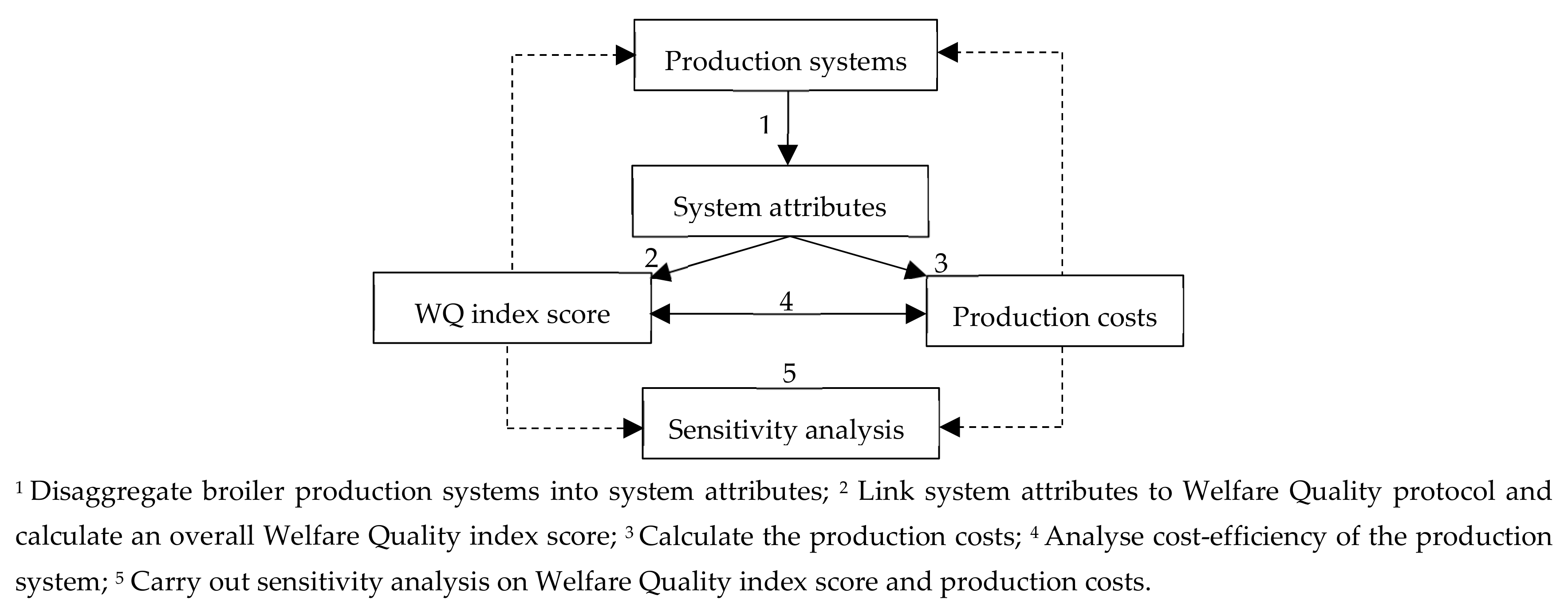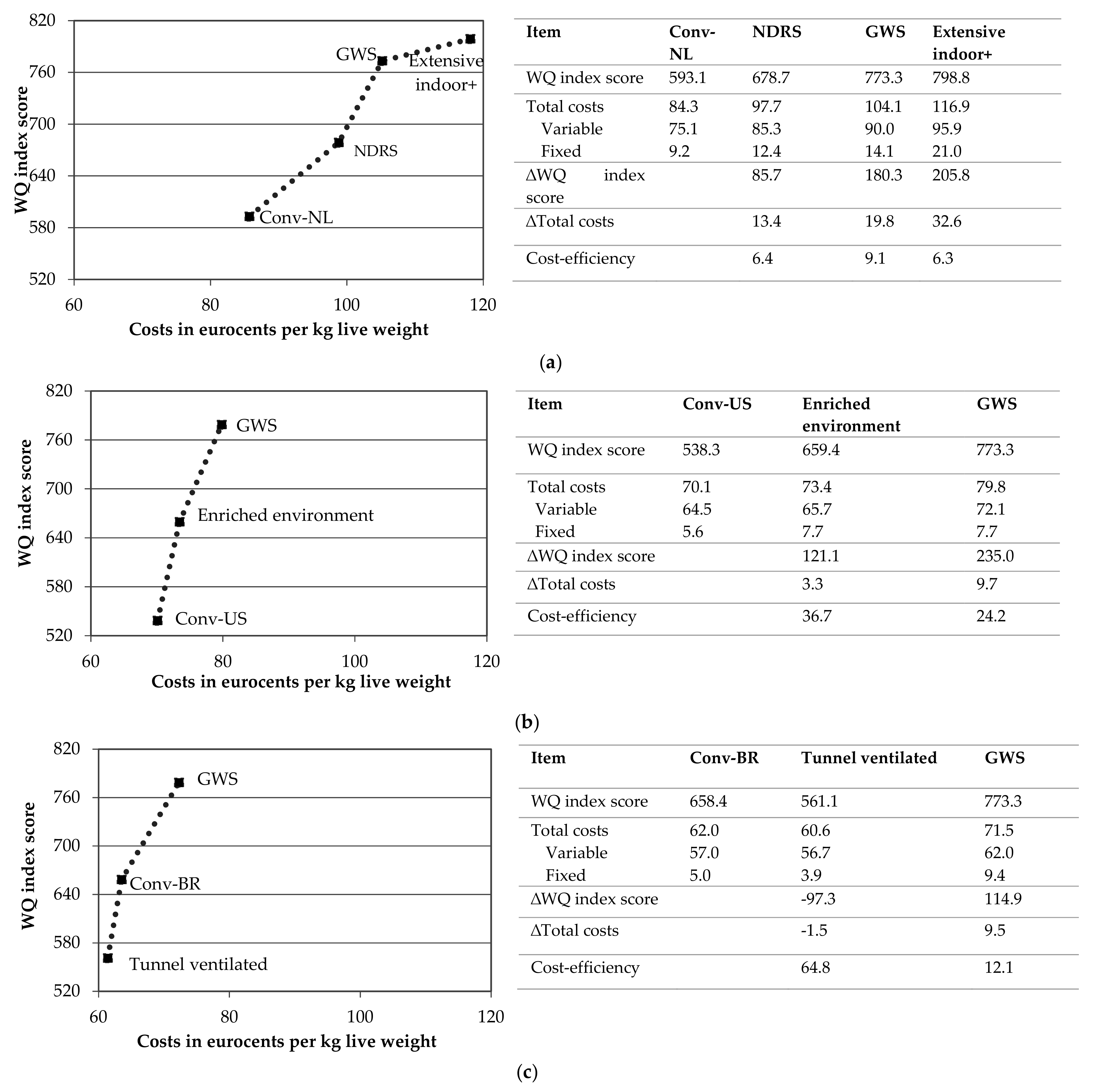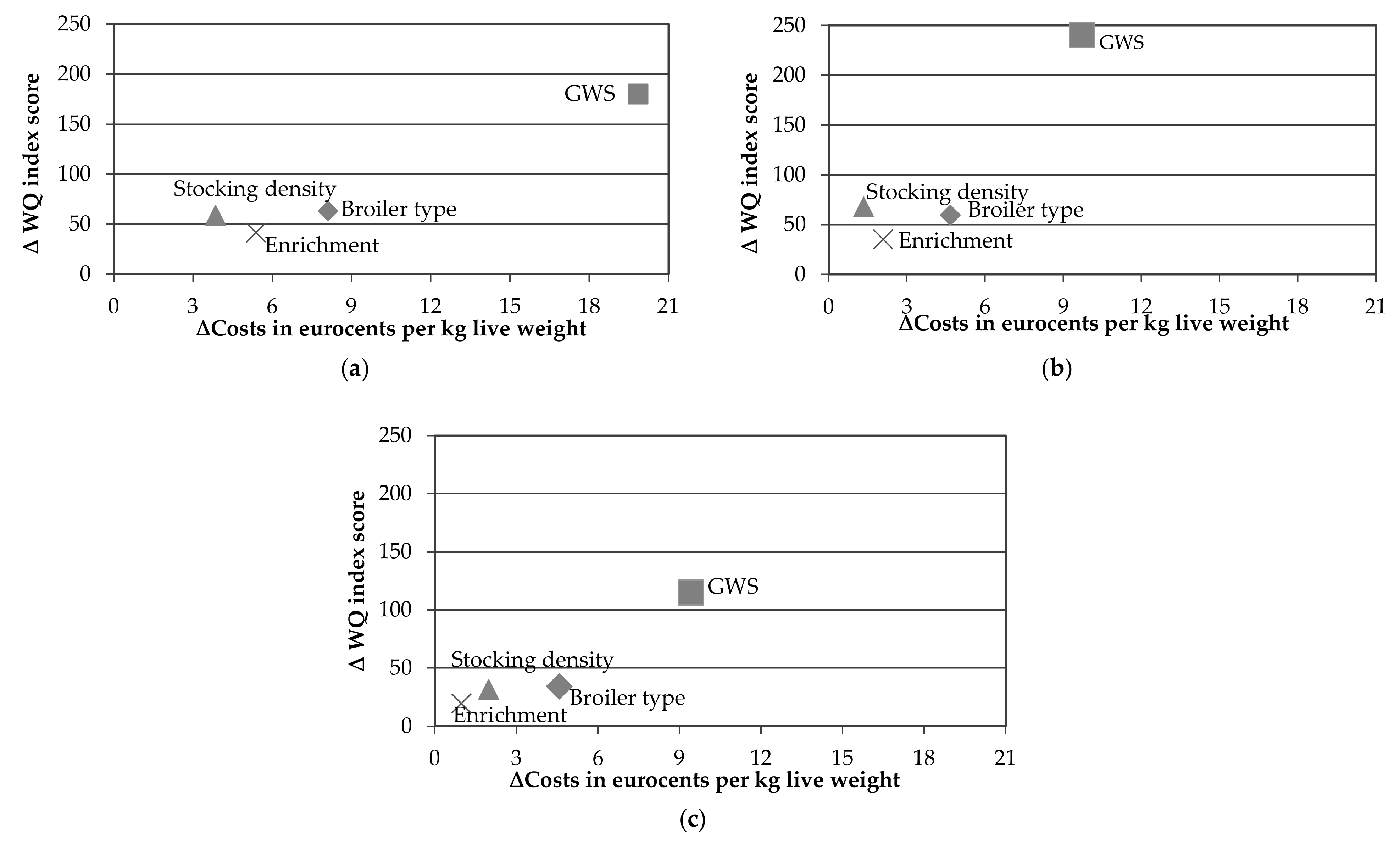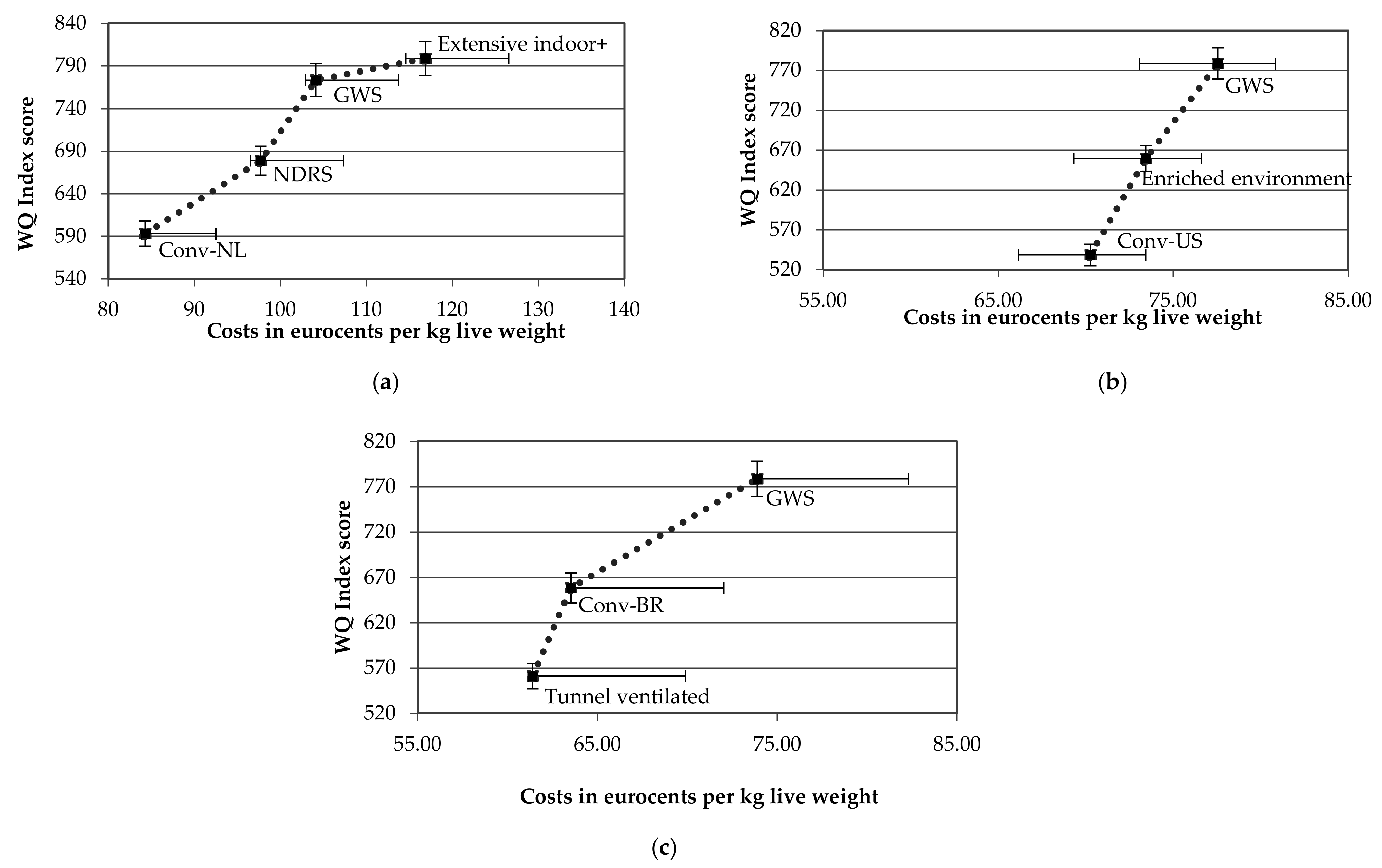Global Prospects of the Cost-Efficiency of Broiler Welfare in Middle-Segment Production Systems
Simple Summary
Abstract
1. Introduction
2. Materials and Methods
2.1. Countries and Corresponding Broiler Production Systems
2.2. Disaggregation of Broiler Production Systems into System Attributes
2.3. Link System Attributes to Welfare Quality Protocol and Calculate an Overall Welfare Quality Index Score
2.3.1. Establishment of Linkages and Weights
2.3.2. Calculation of WQ Index Score
2.4. Calculation of the Production Costs and Cost-Efficiency per Broiler Production System
2.5. Sensitivity Analysis of Broiler Production Systems
3. Results
3.1. Cost-Efficiency of Production Systems
3.2. Cost-Efficiency of System Attributes
3.3. Sensitivity Analysis
3.3.1. Uncertainty in WQ Index Score and Fluctuations in Prices
3.3.2. Uncertainty in Assigning Weights to Linkages
4. Discussion
5. Conclusions
Supplementary Materials
Author Contributions
Funding
Conflicts of Interest
Appendix A
| Country | Production System | Item | |||||
| Live weight | Feed conversion rate (g/g) | Mortality (%) | Feed price (€/100kg) | Day-old chick price (eurocents/bird) | Labour (€/hour) | ||
| The Netherlands | Conv-NL | 2300 [22] | 1.61 [22] | 3.5 [22] | 32.7 [22] | 31.5 [22] | 24.0 [22] |
| NDRS | 2400 [24] | 1.88 [24] | 2.5 [24] | 32.7 [22] | 33.5 [22] | 24.0 [22] | |
| Extensive Indoor+ | 2300 [22] | 2.09 [22] | 2.5 [13] | 32.7 [22] | 33.5 [22] | 24.0 [22] | |
| GWS | 2400 | 1.88 [24] | 2.5 [24] | 32.7 [22] | 33.5 [22] | 24.0 [22] | |
| United States | Conv-US | 2700 [22] | 1.86 [22] | 4.5 [22] | 26.3 [22] | 25.1 [22] | 13.5 [22] |
| Enriched environment | 2700 [22] | 1.86 [22] | 4.5 [22] | 26.3 [22] | 25.1 [22] | 13.5 [22] | |
| GWS | 2700 [22] | 2.03 [22] | 2.5 [24] | 26.3 [22] | 27.1 1 | 13.5 [22] | |
| Brazil | Conv-BR | 2600 [22] | 1.79 [22] | 5.2 [19] | 23.6 [22] | 23.6 [22] | 3.0 [22] |
| Tunnel ventilated | 2600 [22] | 1.79 [22] | 4.0 [22] | 23.6 [22] | 23.6 [22] | 3.0 [22] | |
| GWS | 2600 [22] | 1.96 [22] | 2.5 [24] | 23.6 [22] | 25.6 1 | 3.0 [22] |
Appendix B
| Country | Production System | Variable Costs | Fixed Costs | ||||||||||
| Feed | Day-old chicks | Animal health | Litter | Grain and straw | Catching | Other variable costs 1 | General | Labour | Housing | Equipment | Total | ||
| The Netherlands | Conv-NL | 52.7 | 13.7 | 2.0 | 0.4 | 0 | 2.1 | 4.3 | 0.8 | 2.7 | 3.6 | 2.1 | 84.3 |
| NDRS | 61.5 | 14.0 | 1.5 | 0.6 | 0.6 | 2.0 | 5.0 | 0.8 | 3.5 | 5.1 | 3.1 | 97.7 | |
| GWS | 61.5 | 14.0 | 1.5 | 0.6 | 1.4 | 2.0 | 5.7 | 0.8 | 6.0 | 6.4 | 4.3 | 104.1 | |
| Extensive indoor+ | 68.3 | 14.6 | 1.6 | 1.0 | 0.8 | 2.1 | 7.6 | 0.7 | 4.8 | 9.7 | 5.8 | 116.9 | |
| United States | Conv-US | 48.9 | 9.3 | 1.7 | 0.2 | 0 | 0.2 | 3.6 | 0.7 | 1.5 | 2.3 | 1.7 | 70.1 |
| Enriched environment | 48.9 | 9.3 | 1.7 | 0.2 | 0.6 | 0.2 | 4.7 | 0.7 | 2.3 | 2.7 | 2.1 | 73.4 | |
| GWS | 53.3 | 10.0 | 1.3 | 0.2 | 0.7 | 0.9 | 5.2 | 0.7 | 1.8 | 3.1 | 2.6 | 79.8 | |
| Brazil | Tunnel ventilated | 42.2 | 9.1 | 1.2 | 0 | 0 | 0.2 | 1.5 | 0.4 | 1.5 | 2.0 | 2.5 | 60.6 |
| Conv-BR | 42.2 | 9.1 | 1.2 | 0 | 0 | 0.2 | 2.9 | 0.4 | 2.0 | 1.8 | 2.2 | 62.0 | |
| GWS | 46.3 | 9.9 | 0.9 | 0.2 | 0.7 | 0.2 | 3.8 | 0.4 | 2.3 | 2.8 | 4.0 | 71.5 | |
Appendix C
| Production System | System Attribute | WQ Scores per Attribute | Relative Contribution to WQ Score | ||
| Default weights broiler type (=0.50), stocking density (=0.50) | With new weightsbroiler type (=0.55), stocking density (=0.45) | Default weights broiler type (=0.50), stocking density (=0.50) | New weights broiler type (=0.55), stocking density (=0.45) | ||
| Conv-NL | Broiler type | 229.1 | 233.6 | 38.6% | 39.4% |
| Length growth period | 19.6 | 19.6 | 3.3% | 3.3% | |
| Weight at delivery | 7.5 | 7.5 | 1.3% | 1.3% | |
| Straw bale enrichment | 15.8 | 15.8 | 2.7% | 2.7% | |
| Perch enrichment | - | - | 0.0% | 0.0% | |
| Grain in feed | 3.9 | 3.9 | 0.7% | 0.7% | |
| Stocking density | 102.2 | 97.7 | 17.2% | 16.5% | |
| Natural light | 8.7 | 8.7 | 1.5% | 1.5% | |
| Length dark period | 137.2 | 137.2 | 23.1% | 23.1% | |
| Flock size | 35.9 | 35.9 | 6.1% | 6.1% | |
| Litter floor | 19.4 | 19.4 | 3.3% | 3.3% | |
| Light intensity | 13.7 | 13.7 | 2.3% | 2.3% | |
| WQ index score | 593.0 | 593.0 | 100.0% | 100.0% | |
| NDRS | Broiler type | 260.2 | 264.8 | 38.3% | 39.0% |
| Length growth period | 30.6 | 30.6 | 4.5% | 4.5% | |
| Weight at delivery | 13.1 | 13.1 | 1.9% | 1.9% | |
| Straw bale enrichment | 21.2 | 21.2 | 3.1% | 3.1% | |
| Perch enrichment | - | - | 0.0% | 0.0% | |
| grain in feed | 6.4 | 6.4 | 0.9% | 0.9% | |
| Stocking density | 115.1 | 110.4 | 17.0% | 16.3% | |
| Natural light | 15.4 | 15.4 | 2.3% | 2.3% | |
| Length dark period | 142.1 | 142.1 | 20.9% | 20.9% | |
| Flock size | 25.3 | 25.3 | 3.7% | 3.7% | |
| Litter floor | 28.3 | 28.3 | 4.2% | 4.2% | |
| Light intensity | 21.0 | 21.0 | 3.1% | 3.1% | |
| WQ index score | 678.7 | 678.7 | 100.0% | 100.0% | |
| Extensive indoor+ | Broiler type | 269.1 | 273.9 | 33.7% | 34.3% |
| Length growth period | 41.5 | 41.5 | 5.2% | 5.2% | |
| Weight at delivery | 18.7 | 18.7 | 2.3% | 2.3% | |
| Straw bale enrichment | 26.5 | 26.5 | 3.3% | 3.3% | |
| Perch enrichment | - | - | 0.0% | 0.0% | |
| grain in feed | 9.0 | 9.0 | 1.1% | 1.1% | |
| Stocking density | 164.6 | 159.9 | 20.6% | 20.0% | |
| Natural light | 22.2 | 22.2 | 2.8% | 2.8% | |
| Length dark period | 155.2 | 155.2 | 19.4% | 19.4% | |
| Flock size | 26.3 | 26.3 | 3.3% | 3.3% | |
| Litter floor | 37.3 | 37.3 | 4.7% | 4.7% | |
| Light intensity | 28.4 | 28.4 | 3.6% | 3.6% | |
| WQ index score | 798.8 | 798.8 | 100.0% | 100.0% | |
| GWS | Broiler type | 220.3 | 225.0 | 28.5% | 29.1% |
| Length growth period | 36.9 | 36.9 | 4.8% | 4.8% | |
| Weight at delivery | 15.4 | 15.4 | 2.0% | 2.0% | |
| Straw bale enrichment | 20.0 | 20.0 | 2.6% | 2.6% | |
| Perch enrichment | 94.2 | 94.2 | 12.2% | 12.2% | |
| grain in feed | 8.1 | 8.1 | 1.0% | 1.0% | |
| Stocking density | 129.2 | 124.4 | 16.7% | 16.1% | |
| Natural light | 18.9 | 18.9 | 2.4% | 2.4% | |
| Length dark period | 149.0 | 149.0 | 19.3% | 19.3% | |
| Flock size | 24.4 | 24.4 | 3.2% | 3.2% | |
| Litter floor | 33.2 | 33.2 | 4.3% | 4.3% | |
| Light intensity | 23.6 | 23.6 | 3.1% | 3.1% | |
| WQ index score | 773.3 | 773.3 | 100.0% | 100.0% | |
References
- FAO. Gateway to Poultry Production and Products. Available online: http://www.fao.org/poultry-production-products/products-processing/en/ (accessed on 22 January 2019).
- OECD-FAO. OECD-FAO Agricultural Outlook 2018–2027; Food and Agriculture Organization of the United Nations: Rome, Italy, 2018. [Google Scholar]
- Hiemstra, J.S.; Ten Napel, J. Study of the Impact of Genetic Selection on the Welfare of Chickens Bred and Kept for Meat Production; European Union: Brussels, Belgium, 2013. [Google Scholar]
- Zuidhof, M.; Schneider, B.; Carney, V.; Korver, D.; Robinson, F. Growth, efficiency, and yield of commercial broilers from 1957, 1978, and 2005. Poult. Sci. 2014, 93, 2970–2982. [Google Scholar] [CrossRef] [PubMed]
- EFSA. Scientific opinion on the influence of genetic parameters on the welfare and the resistance to stress of commercial broilers. EFSA J. 2010, 8, 1666. [Google Scholar] [CrossRef]
- Bessei, W. Welfare of broilers: A review. Worlds Poult. Sci. J. 2006, 62, 455–466. [Google Scholar] [CrossRef]
- Lu, J.; Bayne, K.; Wang, J. Current status of animal welfare and animal rights in china. ATLA 2013, 41, 351–357. [Google Scholar] [CrossRef] [PubMed]
- Appleby, M.; Cussen, V.; Garces, L.; Lambert, L.; Turner, J. Long Distance Transport and Welfare of Farm Animals, 2nd ed.; Cabi: Wallingford, UK, 2008; p. 409. [Google Scholar]
- Gocsik, É.; Oude Lansink, A.G.J.M.; Saatkamp, H.W. Mid-term financial impact of animal welfare improvements in dutch broiler production. Poult. Sci. 2013, 92, 3314–3329. [Google Scholar] [CrossRef] [PubMed]
- Gocsik, É.; van der Lans, I.A.; Oude Lansink, A.G.J.M.; Saatkamp, H.W. Willingness of dutch broiler and pig farmers to convert to production systems with improved welfare. Anim. Welf. 2015, 24, 211–222. [Google Scholar] [CrossRef]
- Ellen, H.; Leenstra, F.; Van Emous, R.; Groenestein, K.; Van Harn, J.; van Horne, P.L.M.; De Jong, I.C.; Kense, M.; Mevius, D.; Wagenaar, J. Vleeskuikenproductiesystemen in nederland. Anim. Welf. 2012, 18, 43–48. [Google Scholar]
- Saatkamp, H.W.; Vissers, L.S.M.; Van Horne, P.L.M.; De Jong, I.C. Transition from Conventional Broiler Meat to Meat from Production Concepts with Higher Animal Welfare: Experiences from The Netherlands. 2019; working paper. [Google Scholar]
- Gocsik, É.; Brooshooft, S.D.; De Jong, I.C.; Saatkamp, H.W. Cost-efficiency of animal welfare in broiler production systems: A pilot study using the Welfare Quality® assessment protocol. Agric. Syst. 2016, 146, 55–69. [Google Scholar] [CrossRef]
- European Union. Council directive 2007/43/ec of 28 june 2007 laying down minimum rules for the protection of chickens kept for meat production. Off. J. Eur. Union 2007, L182, 19–28. [Google Scholar]
- Van Horne, P.L.M.; (Wageningen Economic Research, Wageningen, The Netherlands). Personal communication, 2018.
- Mulder, M.; Zomer, S. Dutch consumers’ willingness to pay for broiler welfare. J. Appl. Anim. Welf. Sci. 2017, 20, 137–154. [Google Scholar] [CrossRef] [PubMed]
- National Chicken Council. Animal Welfare Guidelines and Audit Checklist for Broilers; National Chicken Council: Washington, DC, USA, 2017. [Google Scholar]
- Global Animal Partnership. 5-Step Animal Welfare Rating Standards for Chickens Raised for Meat v3.0. Available online: https://globalanimalpartnership.org/wp-content/uploads/2017/08/UPDATEDGAP-Standard-for-Meat-Chickens-v3.0-FINAL.pdf (accessed on 27 November 2017).
- Federici, J.; Vanderhasselt, R.; Sans, E.; Tuyttens, F.; Souza, A.; Molento, C. Assessment of broiler chicken welfare in southern brazil. Revista Brasileira de Ciência Avícola 2016, 18, 133–140. [Google Scholar] [CrossRef]
- Moura, D.; Carvalho, T.; Bueno, L.; Naas, I. Study of Minimum Ventilation Systems in Broiler Houses Using Data Mining Technique; World’s Poultry Science Association: Tours, France, August 2010. [Google Scholar]
- Moura, D.; (University of Campinas, Campinas, Brazil). Personal communication, 2017.
- Van Horne, P.L.M. Competitiveness of The Eu Poultry Meat Sector, Base Year 2015; International Comparison of Production Costs; Wageningen Economic Research; Wageningen UR: Wageningen, The Netherlands, 2017; p. 36. [Google Scholar]
- Albert, H. Nieuwe AH Kip. Available online: https://www.ah.nl/over-ah/meer-doen/dierenwelzijn/kip (accessed on 14 November 2017).
- Blanken, K.; Buisonjé, F.E.D.; Evers, A.G.; Ouweltjes, W.; Schooten, H.A.V.; Verkaik, J.C.; Vermeij, I.; Wemmenhove, H. Kwin 2017–2018. Livestock Research; Wageningen UR: Wageningen, The Netherlands, 2017. [Google Scholar]
- Dierenbescherming. Criteria 1-Star Better Life Hallmark—Broilers. Available online: https://beterleven.dierenbescherming.nl/fileupload/zakelijk/criteria/vleeskuikens/Vleeskuikens_1_ster_-_Versie_5.1._ZW_d.d._01.09.2016.pdf (accessed on 17 November 2017).
- Anonymous. Comparison of the Regulatory Framework and Key Practices in the Poultry Meat Supply Chain in the EU and USA; ADAS UK Ltd. and The University of Arkansas: Helsby, UK, 2016. [Google Scholar]
- Gallo, B.; (Cobb-Vantress, Sao Paolo, Brazil). Personal communication, 2017.
- Carvalho, R.H.; Soares, A.L.; Grespan, M.; Spurio, R.S.; Coró, F.A.G.; Oba, A.; Shimokomaki, M. The effects of the dark house system on growth, performance and meat quality of broiler chicken. Anim. Sci. J. 2015, 86, 189–193. [Google Scholar] [CrossRef] [PubMed]
- Welfare Quality Protocol®. Welfare Quality® Assessment Protocol for Poultry (Broilers, Laying Hens); Welfare Quality® Consortium: Lelystad, The Netherlands, 2009; p. 113. [Google Scholar]
- De Jong, I.C.; Gunnink, H.; Hindle, V.A. Eindrapportage Implementatie Welzijnsmonitor Vleeskuikens: Rapportage Voor Deelnemende Vleeskuikenhouders, Slachterijen en Dierenartspraktijken; Wageningen UR Livestock Research; Wageningen UR: Wageningen, The Netherlands, 2015. [Google Scholar]
- Souza, A.; Sans, E.; Müller, B.; Molento, C. Broiler chicken welfare assessment in globalgap® certified and non-certified farms in brazil. Anim. Welf. 2015, 24, 45–54. [Google Scholar] [CrossRef]
- Riber, A.B.; Van de Weerd, H.; De Jong, I.; Steenfeldt, S. Review of environmental enrichment for broiler chickens. Poult. Sci. 2018, 97, 378–396. [Google Scholar] [CrossRef] [PubMed]
- Averós, X.; Estevez, I. Meta-analysis of the effects of intensive rearing environments on the performance and welfare of broiler chickens. Poult. Sci. 2018, 97, 3767–3785. [Google Scholar] [CrossRef] [PubMed]
- De Jong, I.C.; Gunnink, H.; Hindle, V.A. Implementation of the Welfare Quality Broiler Assessment Protocol–Final Report: Overview of Outcome-Based Measurement of Broiler Welfare and a General Discussion on the Welfare Quality Broiler Assessment Protocol; Wageningen UR Livestock Research; Wageningen UR: Wageningen, The Netherlands, 2015. [Google Scholar]
- Vasdal, G.; Moe, R.; De Jong, I.; Granquist, E. The relationship between measures of fear of humans and lameness in broiler chicken flocks. Animal 2018, 12, 334–339. [Google Scholar] [CrossRef] [PubMed]
- Blokhuis, H.; Miele, M.; Veissier, I.; Jones, B. Improving Farm Animal Welfare: Science and Society Working Together: The Welfare Quality Approach; Wageningen Academic Publishers: Wageningen, The Netherlands, 2013. [Google Scholar]




| Production System | System Attributes | |||||||||
| Broiler Type | Length Growth Period (Days) | Live Weight (Grams) | Out Door | Stocking Density (kg/m2) | Natural Light | Enrichment (Grains, Straw Bales, Perches) | Light Intensity (lux) | Dark Period (Hours/Day) | Floor Type | |
| Applied in all countries | ||||||||||
| Global Welfare Standard | Slower-growing | 1 | 1 | No | 30 | Yes | 2 bales/1000 broilers 2m perch/1000 broilers | 20 | 6 | Concrete with litter [22] |
| The Netherlands | ||||||||||
| Conv-NL | Fast-growing [13] | 38 [22] | 2300 [22] | No | 42 [13] | No [13] | No [13] | 20 [14] | 6 [13] | Concrete with litter [22] |
| New Dutch Retail Standard | Slower-growing [23] | 47 [23] | 2400 [24] | No | 38 [23] | No [23] | 2g/broiler 1 bale/1000 broilers [23] | 20 [14] | 6 [13] | Concrete with litter [22] |
| Extensive Indoor+ | Slower-growing [25] | 51 [22] | 2300 [13] | Cov. veranda ≥ 20% total area [25] | 25 [25] | Yes [25] | 2g/broiler 1 bale/1000 broilers [25] | 20 [25] | 8 [25] | Concrete with litter [22] |
| United States | ||||||||||
| Conv-US | Fast-growing [22] | 46 [22] | 2700 [22] | No | 37 [22] | No [17] | No [17] | 5 [26] | 4 [17] | Concrete with litter [17] |
| Enriched environment | Fast-growing [22] | 46 [22] | 2700 [22] | No | 32 [18] | No [18] | Grains 1% of diet 1 bale/70m2 [18] | 50 [18] | 8 [18] | Concrete with litter [18] |
| Brazil | ||||||||||
| Conv-BR | Fast-growing [22] | 44 [22] | 2600 [22] | No | 34 [22] | Yes [19] | Min 60% grains in feed [21] | Natural light +5 lux [19] | 8 [21] | Dirt with litter [27] |
| Tunnel ventilated | Fast-growing [22] | 44 [22] | 2600 [22] | No | 38 [22] | No [21] | Min 60% grains in feed [21] | 5 [28] | 8 [19] | Dirt with litter [27] |
| Welfare Measures | System Attributes | ||||||||||
| A1. Broiler type | A2. Length growth period | A3. Weight at delivery | A4.1 Enrichment – (straw) bales | A5. % Grain in feed | A6. Stocking density | A7. Natural light | A8. Length dark period | A9. Flock size | A10. Concrete litter floor | A11. Light intensity | |
| 3.1: Plumage cleanliness | 0.25 | 0.25 | 0.25 | 0.25 | |||||||
| 3.2: Litter quality | 0.17 | 0.33 | 0.17 | 0.17 | 0.17 | ||||||
| 4.1: Panting | 0.50 | 0.50 | |||||||||
| 5.1: Stocking density | 1 | ||||||||||
| 6.1: Lameness | 0.13 | 0.13 | 0.13 | 0.13 | 0.25 | 0.13 | 0.13 | ||||
| 6.2: Hock burn | 0.17 | 0.17 | 0.17 | 0.17 | 0.17 | 0.17 | |||||
| 6.3: Foot pad dermatitis | 0.22 | 0.11 | 0.11 | 0.11 | 0.11 | 0.22 | 0.11 | ||||
| 6.4: Breast blister | 1 | ||||||||||
| 7.1: On farm mortality | 0.50 | 0.50 | |||||||||
| 7.3: Ascites | 0.67 | 0.33 | |||||||||
| 7.5: Septicaemia | |||||||||||
| 7.7: Pericarditis | |||||||||||
| 11.1: ADT 1 | 0.67 | 0.33 | |||||||||
| 12.1: QBA 2 | 0.25 | 0.13 | 0.13 | 0.13 | 0.13 | 0.13 | 0.13 | ||||
 Linkage established on literature (white); Linkage based on expert opinion I.C. de Jong, Wageningen Livestock Research (grey).
Linkage established on literature (white); Linkage based on expert opinion I.C. de Jong, Wageningen Livestock Research (grey).| Country | Broiler Production System | Method |
|---|---|---|
| Applied in all countries | GWS | Expert estimation based on data of the Netherlands |
| Netherlands | Conv-NL | Data [30] |
| NDRS | Expert estimation based on data of the Netherlands | |
| Extensive indoor+ | Data [30] | |
| United States | Conv-US | Expert estimation based on data of Brazil |
| Enriched environment | Expert estimation based on data of Brazil | |
| Brazil | Conv-BR | Data [19,31] |
| Tunnel ventilated | Expert estimation based on data of Brazil |
© 2019 by the authors. Licensee MDPI, Basel, Switzerland. This article is an open access article distributed under the terms and conditions of the Creative Commons Attribution (CC BY) license (http://creativecommons.org/licenses/by/4.0/).
Share and Cite
Vissers, L.S.M.; de Jong, I.C.; van Horne, P.L.M.; Saatkamp, H.W. Global Prospects of the Cost-Efficiency of Broiler Welfare in Middle-Segment Production Systems. Animals 2019, 9, 473. https://doi.org/10.3390/ani9070473
Vissers LSM, de Jong IC, van Horne PLM, Saatkamp HW. Global Prospects of the Cost-Efficiency of Broiler Welfare in Middle-Segment Production Systems. Animals. 2019; 9(7):473. https://doi.org/10.3390/ani9070473
Chicago/Turabian StyleVissers, Luuk S.M., Ingrid C. de Jong, Peter L.M. van Horne, and Helmut W. Saatkamp. 2019. "Global Prospects of the Cost-Efficiency of Broiler Welfare in Middle-Segment Production Systems" Animals 9, no. 7: 473. https://doi.org/10.3390/ani9070473
APA StyleVissers, L. S. M., de Jong, I. C., van Horne, P. L. M., & Saatkamp, H. W. (2019). Global Prospects of the Cost-Efficiency of Broiler Welfare in Middle-Segment Production Systems. Animals, 9(7), 473. https://doi.org/10.3390/ani9070473





